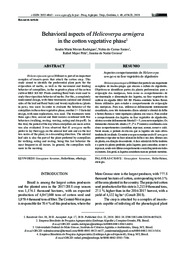Behavioral aspects of Helicoverpa armigera in the cotton vegetative phase.
Behavioral aspects of Helicoverpa armigera in the cotton vegetative phase.
Autoria: RODRIGUES, S. M. M.; SANTOS, N. do C.; PITTA, R. M.; CORASSA, J. de N.
Resumo: US-EN: Helicoverpa armigera (Hübner) is part of an important complex of insects-pests that attack the cotton crop. This study aimed to identify the preferential plant parts for the oviposition of moths, as well as the movement and feeding behavior of caterpillars, in the vegetative phase of the cotton cultivar BRS 369 RF. Plants emitting floral buds were used to study the oviposition behavior of moths. For this, a completely randomized design, with three treatments (adaxial and abaxial sides of the leaf and floral buds) and twenty replications (plants in pots), was used. In order to evaluate the behavior of the caterpillars in the cotton vegetative phase, another 3 × 5 factorial design, with nine replications, was used. The treatments were three ages (first, second and third instars) combined with five behaviors (walking, resting, waving, eating and drop-off). In this trial, the period of the day when caterpillars are more active was also evaluated. It was observed that H. armigera moths prefer to lay their eggs on the adaxial leaf side and on the last two nodes of the plant, in a descending direction. The adaxial leaf side is also the part of the plant preferred by caterpillars for walking, eating and resting, being this last behavior the most frequent in all instars. In general, the caterpillars walk more in the morning. | PT-BR: Helicoverpa armigera (Hübner) faz parte de um importante complexo de insetos-pragas que atacam a cultura do algodoeiro. Objetivou-se identificar partes da planta preferenciais para a oviposição das mariposas, bem como os comportamentos de movimentação e alimentação das lagartas, na fase vegetativa da cultivar de algodão BRS 369 RF. Plantas emitindo botões florais foram utilizadas para estudar o comportamento de oviposição das mariposas. Para isso, utilizou-se delineamento inteiramente casualizado, com três tratamentos (faces adaxial e abaxial da folha e botões florais) e vinte repetições (plantas em vasos). Para avaliar o comportamento das lagartas na fase vegetativa do algodoeiro, adotou-se outro delineamento fatorial 3 × 5, com nove repetições. Os tratamentos foram três idades (1º, 2º e 3º ínstares) combinadas com cinco comportamentos (caminhar, repousar, acenar, comer e cair). Neste ensaio, o período do dia em que as lagartas são mais ativas também foi avaliado. Constatou-se que as mariposas de H. armigera preferem ovipositar na face adaxial da folha e nos dois últimos nós da planta, em direção descendente. A face adaxial da folha também é a parte da planta preferida pelas lagartas para caminhar, comer e repousar, sendo este último comportamento o mais frequente em todos os ínstares. Em geral, as lagartas caminham mais no período matutino.
Ano de publicação: 2019
Tipo de publicação: Artigo de periódico
Unidade: Embrapa Agrossilvipastoril
Palavras-chave: Algodão, Animal behavior, Cotton, Ethology, Etologia, Gossypium, Gossypium Hirsutum, Heliothinae, Mato Grosso, Sinop-MT
Observações
1 - Por padrão são exibidas publicações dos últimos 20 anos. Para encontrar publicações mais antigas, configure o filtro ano de publicação, colocando o ano a partir do qual você deseja encontrar publicações. O filtro está na coluna da esquerda na busca acima.
2 - Para ler algumas publicações da Embrapa (apenas as que estão em formato ePub), é necessário ter, no celular ou computador, um desses softwares gratuitos. Sistemas Android: Google Play Livros; IOS: iBooks; Windows e Linux: software Calibre.
Acesse outras publicações
Acesse a Base de Dados da Pesquisa Agropecuária (BDPA) para consultar o acervo completo das bibliotecas da Embrapa.

